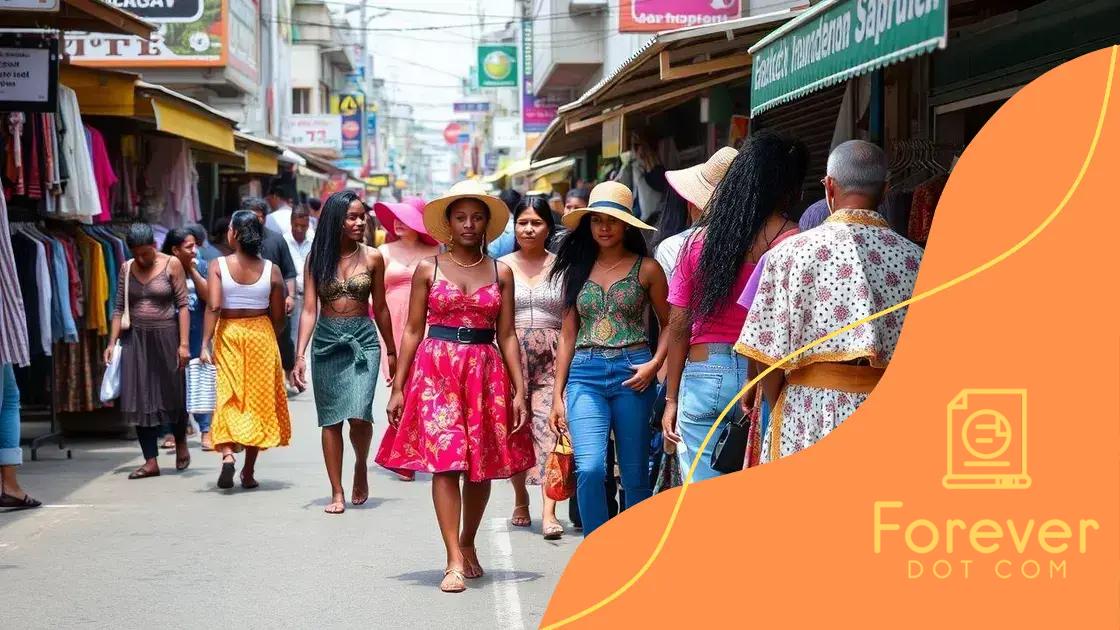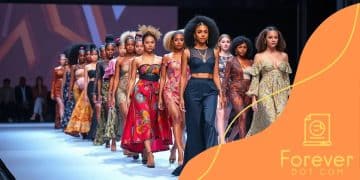Fashion’s role in promoting cultural diversity

Fashion plays a vital role in promoting cultural diversity by showcasing traditional styles, encouraging multicultural collaborations, and inspiring modern design, ultimately fostering understanding and appreciation among different cultures.
Fashion’s role in promoting cultural diversity is more significant than ever. It reflects and amplifies voices from around the world, showing us the beauty in our differences. Have you ever considered how your clothing tells a story?
The influence of fashion on cultural identity
The influence of fashion on cultural identity is profound. Clothing often reflects who we are, where we come from, and our values. Various styles can showcase a rich tapestry of traditions and backgrounds.
Fashion as a Cultural Expression
Different cultures express themselves through unique fashion trends. Traditional garments tell stories and celebrate histories. For example, the kimono from Japan or the sari from India are not just clothing; they embody cultural significance.
How Fashion Shapes Identity
Fashion plays a vital role in shaping individual and group identities. It allows people to express their beliefs and status. Many individuals adopt styles that reflect their heritage or adopt new trends that resonate with their lifestyle.
- Fashion promotes self-expression.
- It fosters community and belonging.
- Adopting styles from different cultures can broaden perspectives.
Moreover, globalization has led to the blending of various cultural styles. As trends cross borders, they encourage appreciation for diversity, helping to unify different cultural identities. This interchange enriches the global fashion scene.
Celebrating Diversity through Fashion
Fashion weeks around the world highlight cultural diversity and allow designers to showcase their roots. This celebration of diversity not only elevates varying cultural narratives but also promotes a deeper understanding among global audiences.
As we explore various cultures through fashion, we invite discussions about authenticity and respect. Fashion can be a powerful tool for cultural appreciation while also raising questions about appropriation. Dialogue on these topics is necessary to foster respect among different cultures.
Cultural influences in fashion can inspire collaboration. Designers often merge traditional techniques with modern aesthetics to create collections that touch on multiple identities. This fusion can lead to stunning creations that pay homage to cultures while appealing to a broader audience.
How traditional styles inspire modern design
How traditional styles inspire modern design is a fascinating topic. Many contemporary designers look to history for inspiration, incorporating age-old techniques and motifs into their work. This fusion creates something new while honoring the past.
The Rich Heritage of Traditional Styles
Traditional styles from various cultures provide a wealth of design ideas. For instance, African prints, Japanese textiles, and Middle Eastern patterns all carry unique stories and aesthetics. These designs often feature vibrant colors, intricate patterns, and meaningful symbolism.
Modern Interpretation of Traditional Elements
Designers today reinterpret these traditional elements to make them relevant for modern audiences. By blending traditional techniques with contemporary styles, they can create unique pieces. This blend can be seen in:
- Fashion that incorporates traditional fabrics into modern silhouettes.
- Home décor that uses ethnic patterns against minimalist backgrounds.
- Art that fuses ancient crafting techniques with modern technology.
As traditional elements are combined with modern aesthetics, the result is often a striking balance. This practice promotes cultural appreciation while also inspiring consumers to embrace diversity in design.
Moreover, the rise of sustainable fashion has fueled a renewed interest in traditional handcrafts. Many designers are returning to ancient techniques to create eco-friendly collections. This choice not only supports artisans but also preserves cultural heritage.
By weaving together old and new, contemporary designers celebrate the beauty of cultural history. This connection generates excitement and storytelling within fashion and design, inviting people from different backgrounds to appreciate each other’s rich traditions.
Fashion as a platform for cultural expression

Fashion serves as a powerful platform for cultural expression. It allows individuals to share their backgrounds, beliefs, and traditions through clothing choices. This expression can be seen in everyday wear, special occasions, or events that celebrate cultural identities.
Diversity in Fashion
Different cultures contribute unique styles and motifs to the fashion world. By wearing these garments, individuals can express their heritage and connect with their roots. For example, the vibrant colors of Mexican textiles or the elegant patterns of Indian garments celebrate cultural history and pride.
Storytelling Through Clothing
Clothing can tell stories, allowing wearers to convey personal narratives. Whether it’s a family heirloom or a modern twist on a traditional outfit, these pieces resonate with deeper meanings. Many designers use fashion to highlight social issues, such as gender equality and environmental sustainability.
- Fashion helps raise awareness about cultural heritage.
- It can challenge stereotypes by showcasing diversity.
- Fashion events often spotlight cultural narratives.
Moreover, fashion promotes dialogue about identity and belonging. By showcasing diverse perspectives, it encourages people to learn about different cultures and appreciate their uniqueness. Clothing becomes a conversation starter, uniting individuals from various backgrounds.
Fashion as a form of cultural expression is also reflected in popular media. Movies, music videos, and social media platforms amplify diverse styles and trends. As influencers showcase their distinctive looks, they inspire others to explore and celebrate their own cultural identities.
This artistic interplay between tradition and modernity enhances our understanding of the world. Fashion designers mix traditional craftsmanship with contemporary techniques, creating collections that honor the past while being relevant today. Wearing these designs becomes not just a personal choice but a statement of cultural pride.
The impact of global fashion weeks
The impact of global fashion weeks is enormous, shaping trends and connecting cultures. These events showcase the latest designs and highlight diverse styles from around the world. Designers use fashion weeks to present innovative ideas and promote cultural narratives.
Showcasing Talents from Around the World
Fashion weeks in cities like Paris, New York, Milan, and London attract global attention. They are platforms where both established and emerging designers showcase their work. This exposure helps to elevate fashion from different cultures, allowing local talents to gain international recognition.
Influencing Trends and Styles
Global fashion weeks heavily influence consumer trends. Designers often set the tone for what is fashionable in the coming seasons. The runway serves as a source of inspiration for retailers and consumers alike, who eagerly look for new styles to adopt.
- Fashion weeks highlight seasonal trends.
- They allow for trend forecasting in the fashion industry.
- Designers often respond to cultural events and issues showcased on the runway.
Moreover, these events have become more inclusive over time. Many fashion weeks now feature diverse models, showcasing a variety of body types and cultural backgrounds. This shift promotes a broader definition of beauty and encourages acceptance of all styles.
In addition to aesthetic influence, global fashion weeks also address sustainability and ethical practices. Designers are increasingly using eco-friendly materials and innovative techniques. This focus raises awareness of environmental issues and encourages the fashion industry to think about its impact.
The conversations sparked during fashion weeks extend beyond the runway. Social media amplifies the reach of these events, allowing audiences worldwide to engage with designers and trends in real time. This interaction fosters a sense of community among fashion enthusiasts, further promoting cultural exchange.
Building bridges through multicultural collaborations
Building bridges through multicultural collaborations is essential in today’s global fashion landscape. By combining ideas and techniques from various cultures, designers create innovative works that reflect a blend of identities. These collaborations not only enrich the fashion scene but also promote understanding and appreciation among different cultures.
The Power of Collaboration
Collaborative projects bring together diverse talents, resulting in unique creations that showcase multiple cultural perspectives. For instance, a collaboration between a traditional artisan and a modern designer can lead to garments that honor heritage while appealing to contemporary tastes. This synergy encourages mutual respect and celebrates the creative spirit.
Breaking Down Stereotypes
When designers collaborate across cultures, they challenge stereotypes that often exist in the fashion industry. By presenting authentic representations of different cultures, these partnerships promote positive narratives and provide a platform for underrepresented voices. Such practices help change the perception of cultural heritage in fashion.
- Collaborations can yield more diverse fashion narratives.
- They allow designers to explore new materials and techniques.
- Multicultural projects encourage inclusivity and understanding.
Additionally, these collaborations enhance the global fashion community by fostering networks of creativity. Designers share techniques, stories, and inspiration, creating a rich environment for artistic growth. This exchange of ideas leads to collections that resonate with broader audiences and highlight the beauty of diversity.
Moreover, multicultural collaborations often focus on social issues, using fashion as a tool for advocacy. By addressing topics like sustainability and ethical production, designers can raise awareness while supporting global movements. This alignment of values creates a deeper connection with consumers who prioritize these principles.
As cross-cultural partnerships become more prevalent, we can expect to see even richer narratives in fashion. Designers will continue to build bridges between cultures, creating iconic pieces that inspire and resonate with people from all walks of life. Fashion thus becomes a powerful medium for storytelling, fostering unity and celebrating the diverse world we live in.
\n
\n
\n
FAQ – Frequently Asked Questions about Fashion’s Role in Promoting Cultural Diversity
How does fashion celebrate cultural diversity?
Fashion celebrates cultural diversity by showcasing traditional styles and designs, allowing people to express their identities and appreciate different heritages.
What is the significance of multicultural collaborations in fashion?
Multicultural collaborations in fashion enrich designs by blending ideas and techniques from various cultures, resulting in innovative creations that promote understanding and respect.
How do global fashion weeks influence trends?
Global fashion weeks set the stage for seasonal trends, enabling designers to showcase their collections that often reflect a mix of cultural influences and styles.
Why is sustainability important in multicultural fashion?
Sustainability is important in multicultural fashion because it raises awareness about ethical practices, encouraging designers to consider their environmental impact while celebrating cultural heritage.






